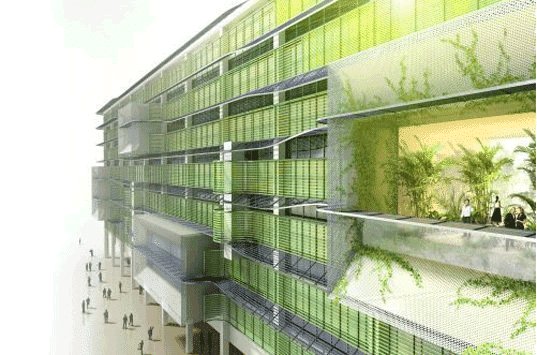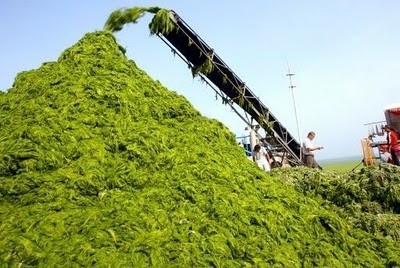
Algae Powered Buildings Isn't As Crazy As It Sounds
Before you think I've jumped off the deep end, the idea of an algae powered building isn't as crazy as it sounds.
In Germany, Hamburg to be exact, has created the world's first algae powered building. This is kinda cool as I've been hearing about it for years, but is been sort of like the search for Jimmy Hoffa; false leads, reported sightings, unconfirmed reports… you get the picture.
Algae powered buildings have been theorized, but not built, up until now.
BIQ has created, according to their website,
"...a Natural, efficient and unique: the BIQ is setting new standards as the first building in the world to have a bioreactor façade. Microalgae are cultivated in the glass elements that make up its “bio skin”. These are used to produce energy, and can also control light and provide shade. Inside, an innovative living concept is aimed at ensuring maximum design versatility for everyday life, and gives us a glimpse into urban life in the future. With its innovative living concept, futuristic exterior, and “intelligent” algae façade…"

Essentially what they have done is on the sides of the building facing the sun, they built a shell of bio reactors around the outside of the building. The point being that the algae enable the building to supply its own energy.
Since it is a bioreactor, all liquid nutrients and carbon dioxide are run through the system. All the algae have to do is grow. Once the algae are mature, they are separated from the rest of the algae into a thick paste, and moved to a 'technical" room.
From there they are fermented in an external biogas plant, to be used as heat and electricity for the building itself.
I'm sure I don't need to say it, but this is radical outside-the-box thinking
The website goes on to say
"The BIQ has a holistic energy concept: it draws all of the energy needed to generate electricity and heat from renewable sources – fossil fuels remain untouched. It is able to generate energy using the algae biomass harvested from its own façade. Moreover, the façade collects energy by absorbing the light that is not used by the algae and generating heat, like in a solar thermal unit, which is then either used directly for hot water and heating, or can be cached in the ground using bore hole heat exchangers — 80 meter-deep holes filled with brine. This remarkably sustainable energy concept is therefore capable of creating a cycle of solar thermal energy, geothermal energy, a condensing boiler, local heat, and the capture of biomass using the bio-reactor façade."
The building was completed on March 22, but won’t be put into full operation until April 25. While I'm not crazy about the color scheme, they get massive points for original, innovative thinking.
What algae powered building means to the "Rest of Us."

Courtesy of http://eluxemagazine.com/
I think we're seeing the beginning of a trend. How big of a trend remains to be seen. But using algae in building design has been talked about for years. That is, incorporating algae into a building's structure in order to provide heating/cooling, electricity, and waste water management.
The question in my mind is how practical is it? Is an algae powered building concept really do-able?
This isn't like a solar panel where all you have to do is slap one up and it produces energy, maintenance free for years. Bio reactors have to be maintained, adjusted, and tinkered with. Maintaining and regulating a system that large to supply energy, as well as waste treatment is a big job. It would mean, on a large scale, a whole new job description created for "bio engineers" in facility management.
The good news is, an algae powered building would create 1000's of new, high tech jobs. My gut feeling is, if this is a success you'll find more and more building adopting some sort of bio facades. Just the heat transfer on glass in a skyscraper is incredible. A reduction in that alone would save $100,000's of dollars a year in heating/cooling costs. If it was taken a step further, then organic fertilizer could also be created to be used on roof top gardening systems as well.
The bad news is, it could also be a maintenance nightmare. If it was the only system, then if it went down, you would lose heating/cooling, electricity, and waste water management. Not a pretty picture. So in the beginning anyway, it would have to be a part of a redundant system, or an auxiliary system, not the main system.
You also be interested in...

Algae Animal Feed
Most algae have a natural high protein content while a high oil content is mostly achieved though manipulation of cultivation conditions. Read More

Algae Bioplastics
“The day where we hit 95 dollars a barrel I think all of a sudden you’re going to see algae bio-plastics basically explode,” That day has come...Read More

Algae in Aquaculture
From fish farms to fish food, algae aquaculture is booming. With the rising price of fish food many aquaculturists are growing their own...Read More
The Algae Revolution Has Begun
I learned more from your eBook than spending $6,000...
Dear David,
I have learned more from your e-book than spending $6,000 going to the Algae World 2009 Conference in Rotterdam. Do you have the same manual for Jatropha? Many thanks,
Thanks in advance
Perpetual Prosperty Pumps, Africa



